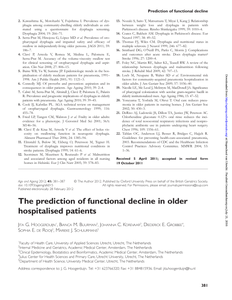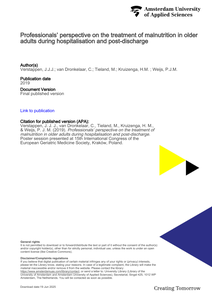Thirty to sixty per cent of older patients experience functional decline after hospitalisation, associated with an increase in dependence, readmission, nursing home placement and mortality. First step in prevention is the identification of patients at risk. The objective of this study is to develop and validate a prediction model to assess the risk of functional decline in older hospitalised patients.
DOCUMENT

DOCUMENT

DOCUMENT

Background: Due to the increasing number of older people with multi-morbidity, the demand for outpatient geriatric rehabilitation (OGR) will also increase. Objective: To assess the effects of OGR on the primary outcome functional performance (FP) and secondary outcomes: length of in-patient stay, re-admission rate, patients’ and caregivers’ quality of life, mortality and cost-effectiveness. We also aim to describe the organisation and content of OGR. Methods: Systematic review and meta-analysis. Five databases were queried from inception to July 2022. We selected randomised controlled trials written in English, focusing on multidisciplinary interventions related to OGR, included participants aged ≥65 and reported one of the main outcomes. A meta-analysis was performed on FP, patients’ quality of life, length of stay and re-admissions. The structural, procedural and environmental aspects of OGR were systematically mapped. Results: We selected 24 studies involving 3,405 participants. The meta-analysis showed no significant effect on the primary outcome FP (activity). It demonstrated a significant effect of OGR on shortening length of in-patient stay (P = 0.03, MD = −2.41 days, 95%CI: [−4.61—0.22]). Frequently used elements of OGR are: inpatient start of OGR with an interdisciplinary rehabilitation team, close cooperation with primary care, an OGR coordinator, individual goal setting and education for both patient and caregiver. Conclusion: This review showed that OGR is as effective as usual care on FP activity. It shows low certainty of evidence for OGR being effective in reducing the length of inpatient stay. Further research is needed on the various frequently used elements of OGR
DOCUMENT

ABSTRACT It is unknown whether heterogeneity in effects of self-management interventions in patients with chronic obstructive pulmonary disease (COPD) can be explained by differences in programme characteristics. This study aimed to identify which characteristics of COPD self-management interventions are most effective. Systematic search in electronic databases identified randomised trials on self-management interventions conducted between 1985 and 2013. Individual patient data were requested for meta-analysis by generalised mixed effects models. 14 randomised trials were included (67% of eligible), representing 3282 patients (75% of eligible). Univariable analyses showed favourable effects on some outcomes for more planned contacts and longer duration of interventions, interventions with peer contact, without log keeping, without problem solving, and without support allocation. After adjusting for other programme characteristics in multivariable analyses, only the effects of duration on all-cause hospitalisation remained. Each month increase in intervention duration reduced risk of all-cause hospitalisation (time to event hazard ratios 0.98, 95% CI 0.97–0.99; risk ratio (RR) after 6 months follow-up 0.96, 95% CI 0.92–0.99; RR after 12 months follow-up 0.98, 95% CI 0.96–1.00). Our results showed that longer duration of self-management interventions conferred a reduction in allcause hospitalisations in COPD patients. Other characteristics are not consistently associated with differential effects of self-management interventions across clinically relevant outcomes.
DOCUMENT

BACKGROUND: Due to the increasing number of older people with multi-morbidity, the demand for outpatient geriatric rehabilitation (OGR) will also increase.OBJECTIVE: To assess the effects of OGR on the primary outcome functional performance (FP) and secondary outcomes: length of in-patient stay, re-admission rate, patients' and caregivers' quality of life, mortality and cost-effectiveness. We also aim to describe the organisation and content of OGR.METHODS: Systematic review and meta-analysis. Five databases were queried from inception to July 2022. We selected randomised controlled trials written in English, focusing on multidisciplinary interventions related to OGR, included participants aged ≥65 and reported one of the main outcomes. A meta-analysis was performed on FP, patients' quality of life, length of stay and re-admissions. The structural, procedural and environmental aspects of OGR were systematically mapped.RESULTS: We selected 24 studies involving 3,405 participants. The meta-analysis showed no significant effect on the primary outcome FP (activity). It demonstrated a significant effect of OGR on shortening length of in-patient stay (P = 0.03, MD = -2.41 days, 95%CI: [-4.61-0.22]). Frequently used elements of OGR are: inpatient start of OGR with an interdisciplinary rehabilitation team, close cooperation with primary care, an OGR coordinator, individual goal setting and education for both patient and caregiver.CONCLUSION: This review showed that OGR is as effective as usual care on FP activity. It shows low certainty of evidence for OGR being effective in reducing the length of inpatient stay. Further research is needed on the various frequently used elements of OGR.
MULTIFILE

Hospitalisation is stressful for children. Play material is often offered for distraction and comfort. Weexplored how contact with social robot PLEO could positively affect a child’s well-being. To this end, we performed a multiple case study on the paediatric ward of two hospitals. Child life specialists offered PLEO as a therapeutic activity to children in a personalised way for a well-being related purpose in three to five play like activity sessions during hospital visits/stay. Robot–child interaction was observed; care professionals, children and parents were interviewed. Applying direct content analysis revealed six categories of interest: interaction with PLEO, role of the adults, preferences for PLEO, PLEO as buddy, attainment of predetermined goal(s) and deployment of PLEO. Four girls and five boys, aged 4–13, had PLEO offered as a relief from stress or boredom or for physical stimulation. All but one started interacting with PLEO and showed behaviours like hugging, caring or technical exploration, promoting relaxation, activation and/or making contact. Interaction with PLEO contributed to achieving the well-being related purpose for six of them. PLEO was perceived as attractive to elicit play. Although data are limited, promising results emerge that the well-being of hospitalised children might be fostered by a personalised PLEO offer.
DOCUMENT

BACKGROUND AND AIMS: Patients with COVID-19 infection presents with a broad clinical spectrum of symptoms and complications. As a consequence nutritional requirements are not met, resulting in weight- and muscle loss, and malnutrition. The aim of the present study is to delineate nutritional complaints, the (course of the) nutritional status and risk of sarcopenia of COVID-19 patients, during hospitalisation and after discharge.METHODS: In this prospective observational study in 407 hospital admitted COVID-19 patients in four university and peripheral hospitals, data were collected during dietetic consultations. Presence of nutrition related complaints (decreased appetite, loss of smell, changed taste, loss of taste, chewing and swallowing problems, nausea, vomiting, feeling of being full, stool frequency and consistency, gastric retention, need for help with food intake due to weakness and shortness of breath and nutritional status (weight loss, BMI, risk of sarcopenia with SARC-F ≥4 points) before, during hospital stay and after discharge were, where possible, collected.RESULTS: Included patients were most men (69%), median age of 64.8 ± 12.4 years, 60% were admitted to ICU at any time point during hospitalisation with a median LOS of 15 days and an in-hospital mortality rate of 21%. The most commonly reported complaints were: decreased appetite (58%), feeling of being full (49%) and shortness of breath (43%). One in three patients experienced changed taste, loss of taste and/or loss of smell. Prior to hospital admission, 67% of the patients was overweight (BMI >25 kg/m2), 35% of the patients was characterised as malnourished, mainly caused by considerable weight loss. Serious acute weight loss (>5 kg) was showed in 22% of the patents during the hospital stay; most of these patients (85%) were admitted to the ICU at any point in time. A high risk of sarcopenia (SARC-F ≥ 4 points) was scored in 73% of the patients during hospital admission.CONCLUSION: In conclusion, one in five hospital admitted COVID-19 patients suffered from serious acute weight loss and 73% had a high risk of sarcopenia. Moreover, almost all patients had one or more nutritional complaints. Of these complaints, decreased appetite, feeling of being full, shortness of breath and changed taste and loss of taste were the most predominant nutrition related complaints. These symptoms have serious repercussions on nutritional status. Although nutritional complaints persisted a long time after discharge, only a small group of patients received dietetic treatment after hospital discharge in recovery phase. Clinicians should consider the risks of acute malnutrition and sarcopenia in COVID-19 patients and investigate multidisciplinary treatment including dietetics during hospital stay and after discharge.
DOCUMENT

Background: after hospitalisation for cardiac disease, older patients are at high risk of readmission and death. Objective: the cardiac care bridge (CCB) transitional care programme evaluated the impact of combining case management, disease management and home-based cardiac rehabilitation (CR) on hospital readmission and mortality. Design: single-blind, randomised clinical trial. Setting: the trial was conducted in six hospitals in the Netherlands between June 2017 and March 2020. Community-based nurses and physical therapists continued care post-discharge. Subjects: cardiac patients ≥ 70 years were eligible if they were at high risk of functional loss or if they had had an unplanned hospital admission in the previous 6 months. Methods: the intervention group received a comprehensive geriatric assessment-based integrated care plan, a face-to-face handover with the community nurse before discharge and follow-up home visits. The community nurse collaborated with a pharmacist and participants received home-based CR from a physical therapist. The primary composite outcome was first all-cause unplanned readmission or mortality at 6 months. Results: in total, 306 participants were included. Mean age was 82.4 (standard deviation 6.3), 58% had heart failure and 92% were acutely hospitalised. 67% of the intervention key-elements were delivered. The composite outcome incidence was 54.2% (83/153) in the intervention group and 47.7% (73/153) in the control group (risk differences 6.5% [95% confidence intervals, CI -4.7 to 18%], risk ratios 1.14 [95% CI 0.91-1.42], P = 0.253). The study was discontinued prematurely due to implementation activities in usual care. Conclusion: in high-risk older cardiac patients, the CCB programme did not reduce hospital readmission or mortality within 6 months.
DOCUMENT

Objective: To study the effects of a comprehensive secondary prevention programme on weight loss and to identify determinants of weight change in patients with coronary artery disease (CAD). Methods: We performed a secondary analysis focusing on the subgroup of overweight CAD patients (BMI ≥27 kg/m2) in the Randomised Evaluation of Secondary Prevention by Outpatient Nurse SpEcialists-2 (RESPONSE-2) multicentre randomised trial. We evaluated weight change from baseline to 12-month follow-up; multivariable logistic regression with backward elimination was used to identify determinants of weight change. Results: Intervention patients (n=280) lost significantly more weight than control patients (n=257) (-2.4±7.1 kg vs -0.2±4.6 kg; p<0.001). Individual weight change varied widely, with weight gain (≥1.0 kg) occurring in 36% of interventions versus 41% controls (p=0.21). In the intervention group, weight loss of ≥5% was associated with higher age (OR 2.94), lower educational level (OR 1.91), non-smoking status (OR 2.92), motivation to start with weight loss directly after the baseline visit (OR 2.31) and weight loss programme participation (OR 3.33), whereas weight gain (≥1 kg) was associated with smoking cessation ≤6 months before or during hospitalisation (OR 3.21), non-Caucasian ethnicity (OR 2.77), smoking at baseline (OR 2.70), lower age (<65 years) (OR 1.47) and weight loss programme participation (OR 0.59). Conclusion: The comprehensive secondary prevention programme was, on average, effective in achieving weight loss. However, wide variation was observed. As weight gain was observed in over one in three participants in both groups, prevention of weight gain may be as important as attempts to lose weight.
LINK